December 25, 2007
Swedish Political Geometry
In time for Christmas we at Eudoxa presented Riksdagens Nštverk 2007, our report on the social networks of the Swedish parliament. The report is in Swedish, but here are some highlights:
Members of the ruling center-right coalition are co-authoring bills with each other across party lines to a great extent. However, the red-green former allies of the Social democrats are also networking with the coalition. Meanwhile the social democrats have not learned to network; as I pointed out last year they did not need to as long as they were in power, but now when they are opposition they seem to be content to raise issues internally. We'll see if that pays off - I'm doubtful.

Connecting members with co-authored bills produces a network with more structure (PDF file; a BIG network with the individual bills too can be found here). The size of the nodes denote betweenness centrality, color party membership.
Most MPs are in the giant component. Unlike last year the center-right alliance is not densely connected (since many proposals can be presented through the cabinet rather than as parliamentary bills), while the left and green parties remain fairly tight. Monica Green of the social democrats gets maximal centrality by being the only link between her isolated party and the rest. The moderate party, although "officially" the most conservative party, actually networks quite widely and becomes quite spread out.

Using Newmann's clustering algorithm finds a bunch of dense subnetworks beside the obvious social democratic network. One is composed of the political middle ground, the rest are various moderate clusters. One 3-person cluster is entirely separate and devoted to liberalizing alcohol sales. One mixed moderate-Christian democrat cluster is apparently the Swedish version of the Christian right. The remaining clusters appear to represent various special interests among the moderate party, like regional issues or alcohol policy.
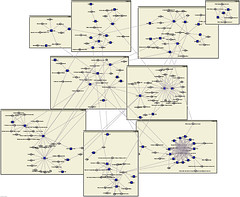
Looking a the bills and members gives a more detailed overview where for example the Scania local issues, Stockholm issues and academic group become visible.
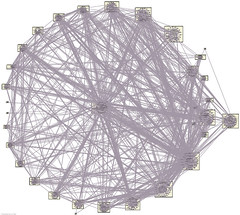
The social democrats have a rather complex internal cluster structure. I don't know enough about them to figure out who is who, but there is plenty of internal structure and working teams.
Similarly the other parties also have differently styled internal structures (Christian democrats, Center party, the liberal party, the green party, the left party). The greens seem to co-author intensely, probably regulated by a strong party whip. The left party appears to have functional groupings with heavy overlaps.
The center party, traditionally an agrarian countryside party with green tendencies has recently gained a more liberal/libertarian side. However, the network diagrams suggest that they network more outside their own party (including with the greens and the left) rather than into the party.
The most central bills were about internet security, freeing Dawit Isaak, human rights in Tibet, authorized guardian angels (protection for battered women), promoting companies with a social conscience, consumer policy and rules for castration of cats. That is, politically correct bills that nobody can be against.
The most central MPs were somewhat different from last year, but the greens and reds are still having the top bridge builders (beside Monica Green). Overall, they seem to realize the use of networking while the social democrats assume it is just numbers that will win the day (after next election).
December 24, 2007
Universal Equations
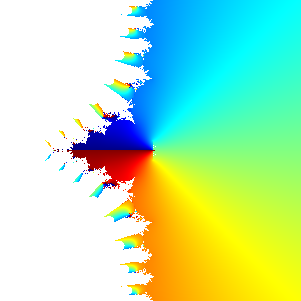 Here is a cool result: for any continuous function f(x) there is a solution y(x) of the equation y''''y'2-3y'''y''y'+2(1-n-2)y''3=0 so that |f(x)-y(x)| < epsilon(x), where epsilon is any positive continuous function. That is, there is a solution that approximates nearly any function you care to name arbitrarily well.
Here is a cool result: for any continuous function f(x) there is a solution y(x) of the equation y''''y'2-3y'''y''y'+2(1-n-2)y''3=0 so that |f(x)-y(x)| < epsilon(x), where epsilon is any positive continuous function. That is, there is a solution that approximates nearly any function you care to name arbitrarily well.
This is from the paper Another universal differential equation by Keith Briggs. It is a simpler version of Rubel's universal differential equation.
This reminds me of another cool result. Voronin showed that the Riemann zeta function is universal in the sense that for any complex analytic function that has no zero in a disk of radius 1/4 around the origin, there is a piece of the zeta function along the line Re(z)=3/4 that is closer to it than epsilon, for any epsilon. This in turn implies that it is a fractal in a sense (since it approximates small pieces of itself), that it is a catalog of all smooth continuous line drawings, and that any text is represented in Morse code somewhere in the zeta function domain.
I think this implies that the Mandelbrot-like set in the picture (which is the Mandelbrot set for the zeta function) ought to contain nearly any other Mandelbrot-like set. So while the usual Mandelbrot set does not contain the cubic Mandelbrot, this one ought to contain both since in small regions we get local dynamics that looks exactly like z^2+c and z^3+c. Finding them is another matter entirely.
December 22, 2007
Fibonacci Fractals and Golden Cosmology
Here are some Newtonmas fractals, based on the de Moivre-Binet formula for Fibonacci numbers:
z(n+1)=(phi^n - (-phi)^n)/sqrt(5)
It has two attractors, 1 and infinity. Like sin(z), exp(z) and cosh(z) we get a "palm frond" structure of points escaping towards infinity along the positive or negative direction, but also small clouds not looking too dissimilar from Julia sets from the main Mandelbrot cardioid.
I got the idea of looking at the function from seeing the paper The Golden Section, Fibonacci series and new hyperbolic models of Nature by Alexey Stakhov and Boris Rozin. They define hyperbolic Fibonacci sines and cosines by analogy with the hyperbolic sine and cosine, showing a number of nice identities.
They also unfortunately succumb to the temptation - endemic among everybody working with the golden ratio - of assuming that these results have some kind of cosmological significance. Yes, the golden ratio and Fibonacci numbers are ubiquitous. But that just means that if they show up in cosmology we should be unsurprised. But I have no doubt that some people would reject a cosmological or fundamental physics theory because it involved a rare or "boring" constant like 4/5 or 17. Or maybe one could make a maximum entropy argument, and claim that the most a priori likely theory has the most a priori likely component constants?
December 14, 2007
Come over to the dark side...we have candy
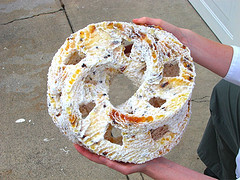 Evil Mad Scientist Laboratories - Solid freeform fabrication: DIY, on the cheap, and made of pure sugar. Photoset here.
Evil Mad Scientist Laboratories - Solid freeform fabrication: DIY, on the cheap, and made of pure sugar. Photoset here.
Solid freeform fabrication is cool, making elaborate sugar confections is cool, so the combination is of course cool squared. And, as the essay shows, surprisingly cheap and simple if you do not aim for submilimeter precision.
The bakery potential is awesome. And it shows how fabbing is gradually becoming ever more practical. If the Lego Group is not buying fabbing stock or planning their own fabber it will be outcompeted by homeprinted pieces. Together with printable plastic electronics this is going to change everyday life in truly unexpected ways in a few years. Hmm, I wonder if we can achieve edible plastic electronics? Since the environmental impact will be important for all forms of fabbing, aiming for edibility might be a good long term goal.
Maybe the gingerbread cottage of the witch was a good idea, after all.
[ Overall, the site has many other great projects. I especially liked making Sierpinski triangles with clay ]
December 10, 2007
More Disloyal Machines
 Today on Practical Ethics I write about Who is your hard drive working for?
Today on Practical Ethics I write about Who is your hard drive working for?
The cause is the Western Digital debacle, where the company software prevents their networked hard drives from sharing many kinds of media files "due to unverifiable media license authentication". This of course prevents people from sharing media they do have the right to share, making many users quite irate.
I reacted too, because I was very close to actually buying one of these drives. There is much to be said for user-friendly packaging and Morse-code subliminal grills. But I also demand loyalty of my possessions.
The blog post goes into some of the issues of property rights, looking at whether they give a basis for demanding loyalty. It turns out that they may not be enough. I have a right to control the use of my property and exclude others from my property, which definitely supports my demands of loyalty, but these rights can relatively easily be circumscribed by contracts, licensing and public goods concerns that break up my bundle of rights. Even leaving out egregious EULAs, information asymmetries between sellers and buyers and misleading advertising there seem to be good grounds to think that we cannot demand absolute loyalty. It is still a good thing though, since it places responsibility on human shoulders rather than relying on rigid rule systems.
Another serious problem with this kind of automated control is that it is ideal for censorship. While Western Digital probably worried about being accused of facilitating piracy under the DMCA, it is not hard to see how the threat of other laws could add further limitations. For example, given the UK rules - and enforcement - against "collecting or possessing information useful in the preparation of an act of terrorism" it would be illegal to have The Anarchist Cookbook on any hard drive, and clearly putting it on a net-enabled drive would be even more illegal. So it would be rational for Western Digital to add screening software for banned books to the hard drives, just in order to prevent any accusations that it was aiding terrorism.
It is also not hard to imagine translating current ISP-level filtering against child porn into automated filtering of what is sent from net drives (the software just needs to update a list of file hashes downloaded from the authorities from time to time). And as demonstrated in Sweden where the police began using the child porn filter against pirate sites too, it is easy to get mission creep. There is a nasty synergy between "protections" against terrorism, child porn and piracy, and once a technical solution to one has been instituted it can easily be extended to the others. Given the weight most people give to them, the overspill, chilling effects and security theatre is excused as regrettable but necessary and criticism as treason and immorality.
This slippery slope has not happened yet. But we better nip it in the bud (sand the slope?) by demanding more control over our hardware and fewer automated decisions (with no appeals) about what we can and cannot do.
December 08, 2007
But WHO is Refusing the Treatment?
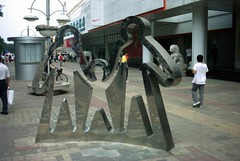 I blogged a while ago on CNE about whether sufferers of anorexia nervosa were competent to refuse treatment. It is a tricky issue, since they are not incompetent in the usual sense (inability to understand basic facts and reason from them) but the issue might be more that they hold what could perhaps be called pathological values: in many cases reasoning is fine, it is just that it is based on values, emotions or self-images that could be called irrational. This is not just a problem in AN, and it fits in with the richer and messier image of decisionmaking modern cognitive neuroscience is developing.
I blogged a while ago on CNE about whether sufferers of anorexia nervosa were competent to refuse treatment. It is a tricky issue, since they are not incompetent in the usual sense (inability to understand basic facts and reason from them) but the issue might be more that they hold what could perhaps be called pathological values: in many cases reasoning is fine, it is just that it is based on values, emotions or self-images that could be called irrational. This is not just a problem in AN, and it fits in with the richer and messier image of decisionmaking modern cognitive neuroscience is developing.
But it is problematic from an autonomy perspective. Traditional autonomy was assumed to be binary and not to have fussy edges (or a fuzzy core). Paternalists love to claim autonomy is not everything, but there does not seem to be any principled way of weighing different influences together.
I think figuring out how to think about autonomy, freedom, identity, responsibility and all the other high-level abstractions we build our ethical systems on in terms of the new neurocognitive findings, that is the prime problem for neuroethics.
December 04, 2007
Steady of heart and stout of hand
 Sometimes impressive luck and tenacity isn't enough. When i saw the news headline artificial heart man dies aged 68 I guessed it had to be Peter Houghton. There are not that many people around with artificial hearts, especially people who are so newsworthy.
Sometimes impressive luck and tenacity isn't enough. When i saw the news headline artificial heart man dies aged 68 I guessed it had to be Peter Houghton. There are not that many people around with artificial hearts, especially people who are so newsworthy.
My favorite memory of Peter is from the TransVision 2001 conference in Berlin. He had lectured about his experiencs and we were all in awe of him, yet we all felt a bit of concern that he might be fragile. In the evening we went to visit the BodyWorlds exhibition, itself a quite memorable experience. As we approached the section dealing with the circulatory system my anticipation and slight worry grew. But Peter took the opportunity to hold an impromptu extra lecture, pointing at the different preparations and using them as visual explanations of how his implant worked. It was a marvellous experience and completely dispelled the image that he was frail and not to be disturbed. Instead he took charge and made the most of his "bonus years", something we are deeply thankful for.
December 02, 2007
Mohammed in the Main Belt
 Apropos the Mohammed-teddy controversy, I noted that there are three asteroid partially named Mohammed: (13380) Yamamohammed, (15452) Ibramohammed and (20450) Marymohammed. They have all been named for finalists in middle- or highschool science talent searches. I am pretty certain there are many more objects like this in the world ready to annoy people who like to be annoyed.
Apropos the Mohammed-teddy controversy, I noted that there are three asteroid partially named Mohammed: (13380) Yamamohammed, (15452) Ibramohammed and (20450) Marymohammed. They have all been named for finalists in middle- or highschool science talent searches. I am pretty certain there are many more objects like this in the world ready to annoy people who like to be annoyed.
I must say that naming asteroids after pupils doing good science projects is a great idea. I think this kind of reward should be more common in science: let's reward interested students and amateurs doing important if tedious gruntwork by putting their names on something. There are lots of minor craters and Kuiper-belt objects out there!

